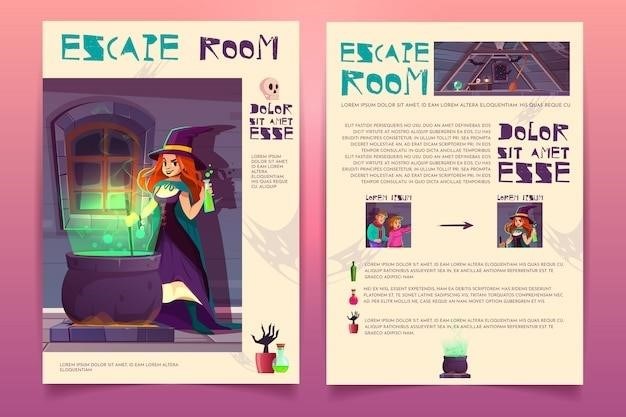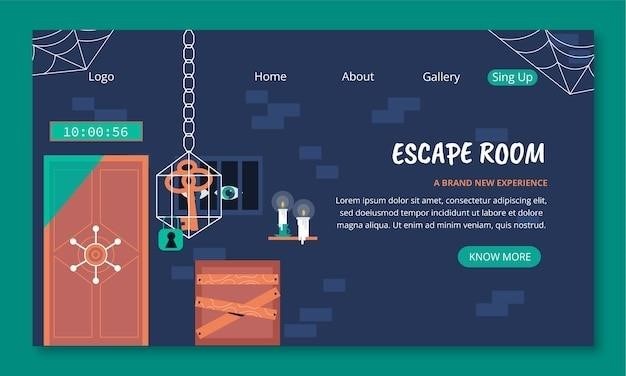Designing Effective Nursing Escape Room Scenarios
Crafting engaging nursing escape room scenarios requires careful planning. Define clear learning objectives, select relevant scenarios and puzzles, and build a compelling narrative that integrates seamlessly with nursing principles and procedures. Prioritize realism and educational value within the game’s structure.
Defining Learning Objectives and Themes
Before designing a nursing escape room, clearly define specific, measurable, achievable, relevant, and time-bound (SMART) learning objectives. These objectives should directly relate to essential nursing skills and knowledge. For example, an escape room might aim to improve competency in medication administration or enhance understanding of patient assessment. The chosen theme should directly support these objectives, creating a cohesive and immersive learning experience. Consider themes relevant to nursing practice, such as a hospital emergency, a simulated patient scenario, or a critical care unit challenge. Ensure the theme is engaging and appropriate for the target audience’s experience level to maximize participation and knowledge retention. A well-defined theme and clear objectives are crucial for a successful and impactful escape room experience.
Selecting Appropriate Scenarios and Puzzles
Choosing the right scenarios and puzzles is key to a successful nursing escape room. Scenarios should reflect real-world nursing challenges, incorporating realistic patient presentations and clinical situations. Puzzles should be directly related to the learning objectives and seamlessly integrated into the scenario’s narrative. Consider using a variety of puzzle types, including logic puzzles, riddles, code-breaking, and physical challenges, to cater to different learning styles and maintain engagement. Ensure puzzles are appropriately challenging for the participants’ skill level, avoiding frustration while still requiring critical thinking and problem-solving. The difficulty should progressively increase to maintain interest and build confidence as the participants advance. Remember to clearly define the solution to each puzzle and how it contributes to the overall escape room narrative and learning objectives. Thoroughly testing the puzzles beforehand is crucial to ensure smooth gameplay and a rewarding learning experience.
Creating Engaging Narratives and Storylines
A captivating narrative is crucial for a successful nursing escape room. The storyline should be immersive and relevant to nursing practice, drawing participants into a compelling scenario. Consider using a patient case study as the central theme, weaving in relevant medical information and clinical challenges. The narrative should guide participants through the puzzles, providing context and motivation to solve them. Maintain a balance between realism and engaging storytelling, avoiding overly complex or confusing plots. Develop a clear beginning, middle, and end to the storyline, ensuring a satisfying resolution. Use visual aids, props, and environmental details to enhance the narrative and create a more immersive experience. Remember to incorporate feedback mechanisms throughout the storyline to reinforce learning and provide opportunities for reflection on critical decision-making. A well-crafted narrative can transform a simple puzzle-solving exercise into a valuable and memorable learning experience.

Practical Implementation and Assessment
Successful escape room implementation involves careful environment setup, efficient resource management, and robust student learning assessment. Post-activity debriefing and feedback mechanisms are crucial for evaluating effectiveness and identifying areas for improvement.
Setting Up the Escape Room Environment
Transforming a space into an immersive escape room demands meticulous planning. Consider the room’s size and layout, ensuring sufficient space for participants to move freely and interact with puzzles. Themed decorations and props enhance immersion, but safety is paramount; remove trip hazards and ensure clear pathways. Adequate lighting is crucial for visibility and mood setting. Clearly defined boundaries and designated areas for different puzzle elements prevent confusion. Pre-testing the room with a small group allows for adjustments before the main event, ensuring a smooth and engaging experience for all participants. Remember to prepare any necessary technology or equipment beforehand to avoid disruptions during the game. A well-organized and safe environment contributes significantly to the overall success of the escape room experience.
Managing Time and Resources Effectively
Effective time management is crucial for a successful escape room experience. Before starting, establish a realistic timeframe, considering the complexity of the puzzles and the number of participants. Allocate sufficient time for setup, gameplay, and debriefing sessions. Create a detailed schedule outlining each phase to avoid time constraints. Resource allocation involves careful budgeting; factor in costs for materials, props, technology, and potentially, facilitator fees. Utilize readily available resources whenever possible, creatively repurposing existing materials to minimize expenses. Delegate tasks efficiently among team members if applicable, assigning responsibilities to maximize productivity. Efficient time and resource management ensures a smooth and cost-effective escape room activity that delivers maximum learning outcomes within the allocated timeframe.
Assessing Student Learning and Feedback
Post-escape room assessment is vital to gauge learning effectiveness. Employ a multifaceted approach, incorporating both formative and summative evaluations. Formative assessments, such as observation during gameplay and informal discussions, provide immediate feedback and identify areas needing improvement. Summative assessments, such as post-activity quizzes or reflective essays, measure knowledge retention and skill application. Collect quantitative data through surveys or questionnaires to gauge student satisfaction and perceived learning gains. Qualitative data, gathered through focus groups or individual interviews, provides rich insights into the learning experience and identifies areas for improvement in future iterations. Analyze the collected data to identify strengths and weaknesses of the escape room design and refine it for future use. Actively solicit feedback from students to enhance future escape room designs and maximize their educational value.

Utilizing Technology and Virtual Escape Rooms
Integrating technology enhances escape room experiences. Virtual reality (VR) and augmented reality (AR) create immersive simulations. Interactive online platforms offer flexible, accessible learning environments. Careful assessment of virtual escape rooms’ effectiveness is crucial.
Integrating Virtual Reality and Augmented Reality
Virtual Reality (VR) and Augmented Reality (AR) technologies offer transformative potential for nursing escape rooms. VR can fully immerse students in realistic patient scenarios, allowing them to practice procedures and decision-making in a safe, controlled environment. Imagine a VR simulation where students respond to a cardiac arrest, practicing intubation and administering medications under pressure, receiving immediate feedback on their actions. AR, conversely, overlays digital information onto the real world. This could involve using AR apps to identify and interact with virtual medical equipment within a physical escape room setting, enhancing engagement and realism. The combination of VR and AR can create truly innovative and effective learning experiences, pushing the boundaries of traditional nursing education and simulation.
Developing Interactive Online Escape Room Experiences
The digital age demands innovative learning methods, and online escape rooms perfectly meet this need. Developing interactive online experiences requires careful consideration of platform selection and user interface design. Platforms like Google Forms, dedicated escape room creation software, or even custom-built applications can host the experience. The key is to create intuitive interfaces that seamlessly integrate puzzles, clues, and narrative. Think of incorporating interactive elements such as drag-and-drop puzzles, branching scenarios based on player choices, and timed challenges to maintain engagement. Multimedia elements such as videos, audio clips, and interactive diagrams can enhance the learning experience. Accessibility features must also be prioritized to ensure inclusivity for all learners. Thorough testing and iterative refinement are crucial for a polished and effective online escape room.
Assessing the Effectiveness of Virtual Escape Rooms
Evaluating the success of virtual escape rooms necessitates a multi-faceted approach. Pre- and post-tests can measure knowledge gain related to specific learning objectives. Qualitative feedback, gathered through surveys or focus groups, provides insights into student engagement and satisfaction. Analyzing player interactions within the virtual environment—completion times, puzzle-solving strategies, and choices made at decision points—can reveal valuable data about learning processes and areas needing improvement. Comparing the performance of participants using virtual escape rooms with those using traditional methods offers valuable comparative data. The effectiveness of the virtual escape room should be assessed not only on knowledge acquisition but also on skill development, problem-solving abilities, and teamwork. This comprehensive evaluation ensures that virtual escape rooms contribute effectively to nursing education goals.
Best Practices and Future Directions
Prioritize safety and inclusivity in design. Explore emerging technologies like VR/AR for enhanced engagement and realistic simulations. Continuously evaluate and refine escape room designs based on student feedback to optimize learning outcomes.
Ensuring Safety and Inclusivity in Escape Room Design
Safety is paramount when designing nursing escape rooms. Clearly defined rules and guidelines must be established before commencement, emphasizing safe handling of props and equipment. The environment should be free from hazards and potential tripping risks. Inclusivity is crucial; design scenarios and puzzles that cater to diverse learning styles and abilities, avoiding biases or assumptions. Consider accessibility needs for participants with disabilities, ensuring all can actively participate and contribute to the team’s success. Provide clear instructions and visual aids where necessary, promoting a supportive and inclusive learning experience for all participants.
Exploring Emerging Trends and Technologies
The integration of virtual and augmented reality (VR/AR) presents exciting possibilities for nursing escape rooms. VR can create immersive simulations of complex clinical scenarios, enhancing engagement and realism. AR overlays digital information onto the real world, enabling interactive learning experiences with real-world objects. Furthermore, the development of interactive online escape rooms offers flexibility and accessibility, allowing for asynchronous learning and participation from diverse locations. These technological advancements offer opportunities to create dynamic, engaging, and effective learning experiences that enhance the traditional escape room format while addressing the ever-evolving needs of nursing education.